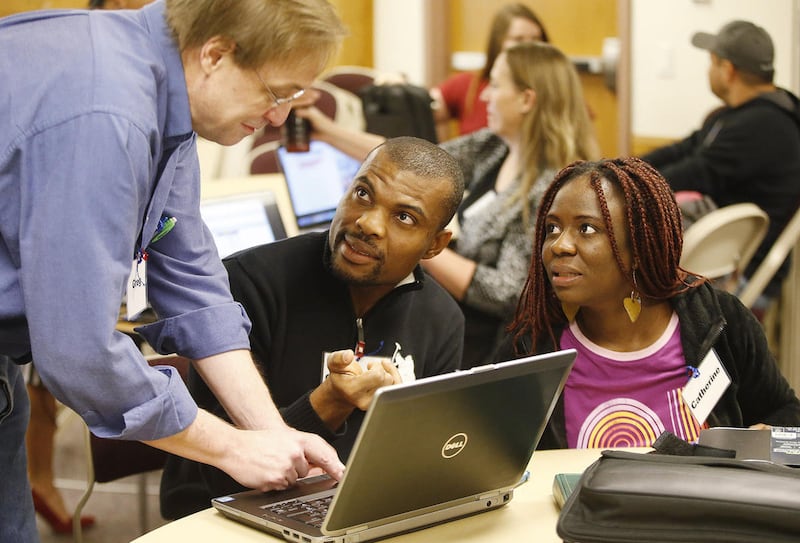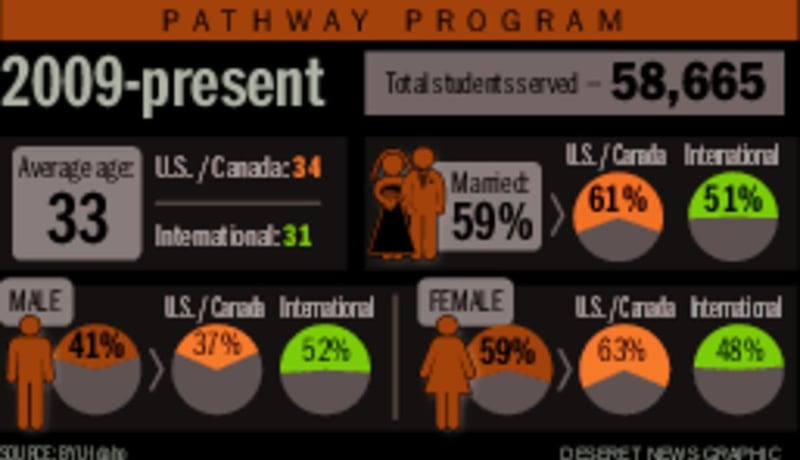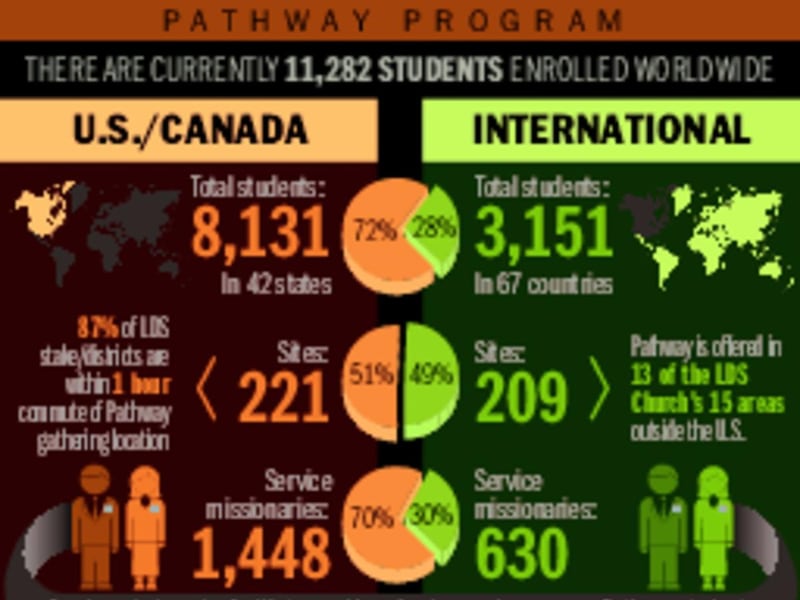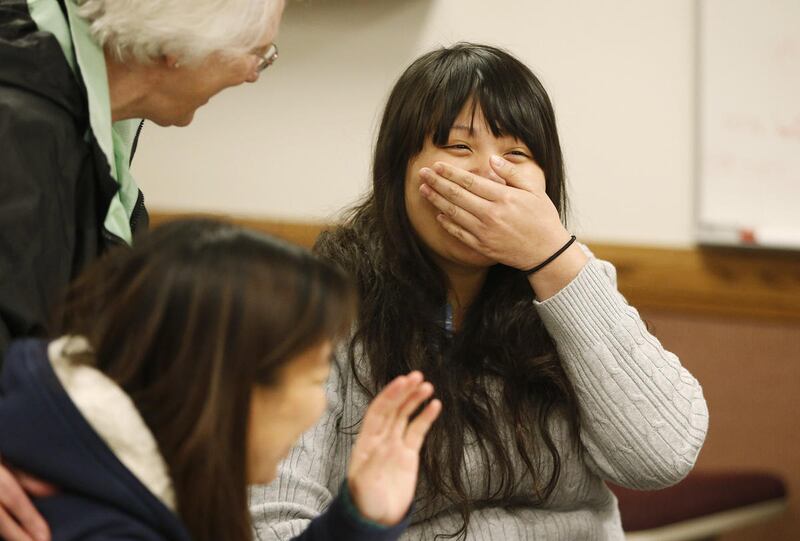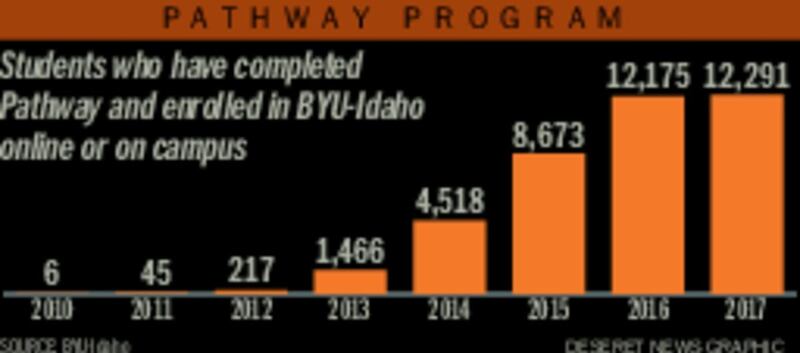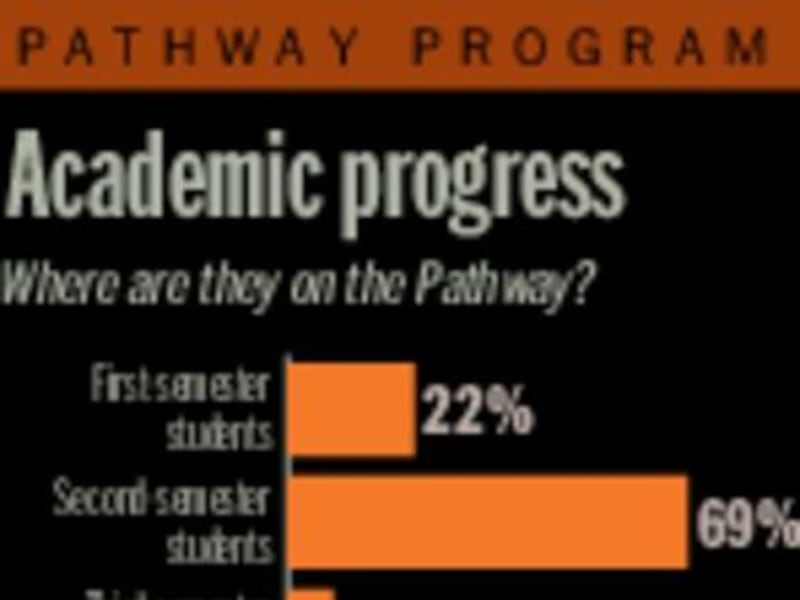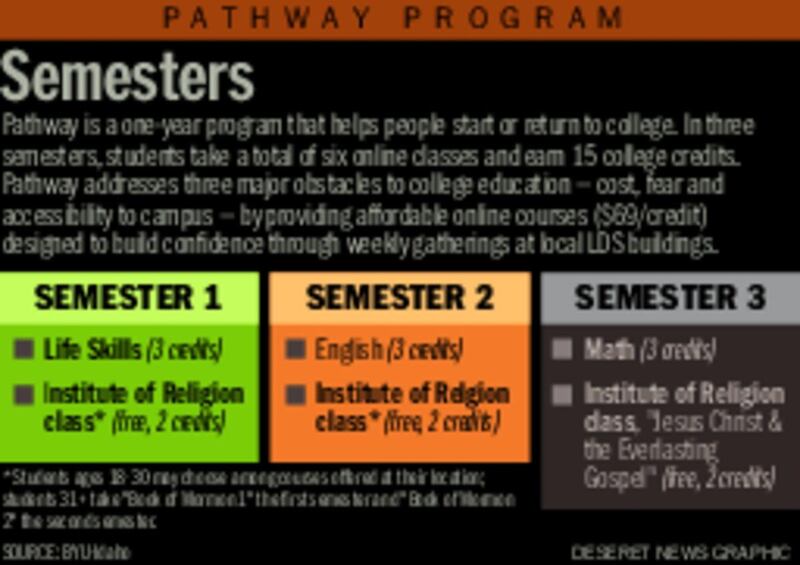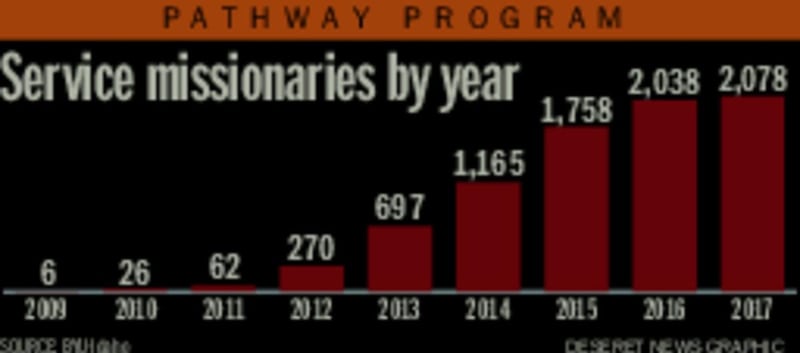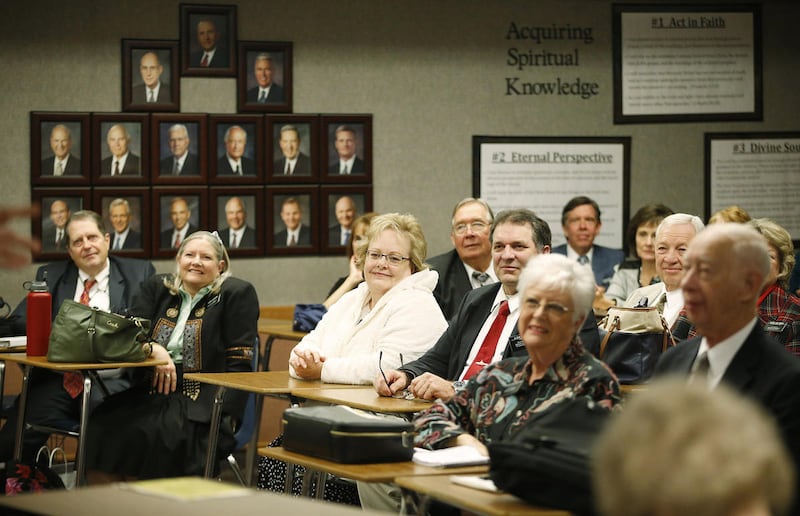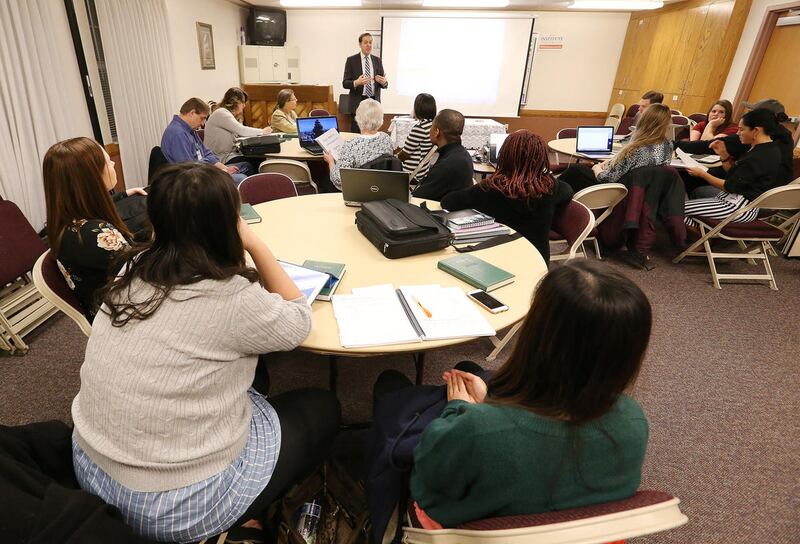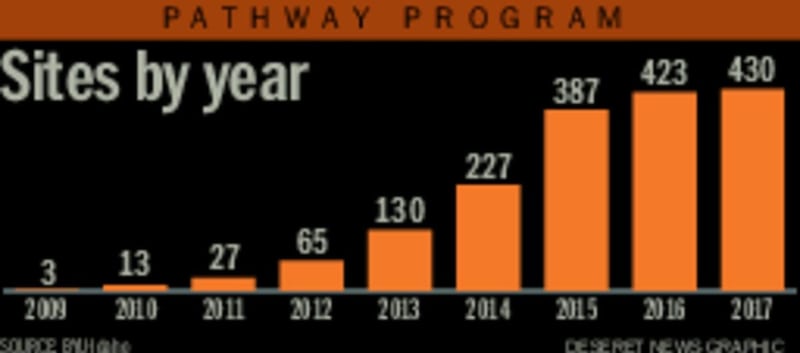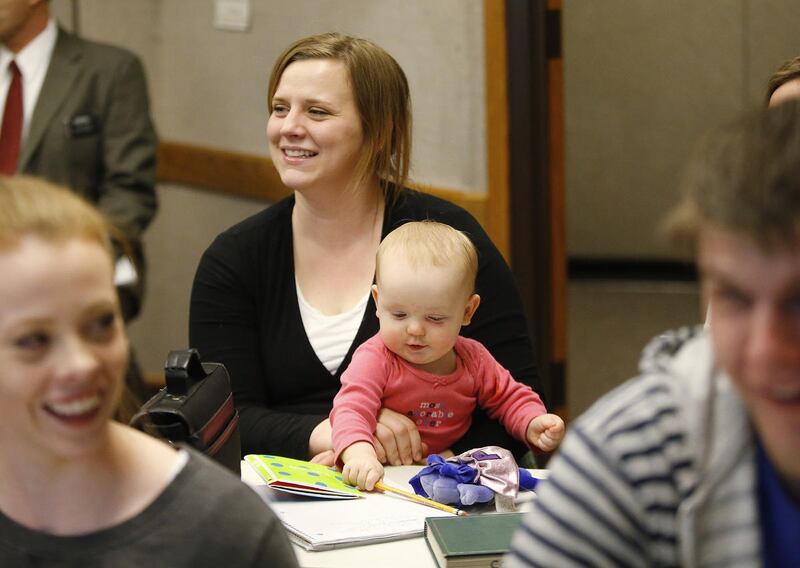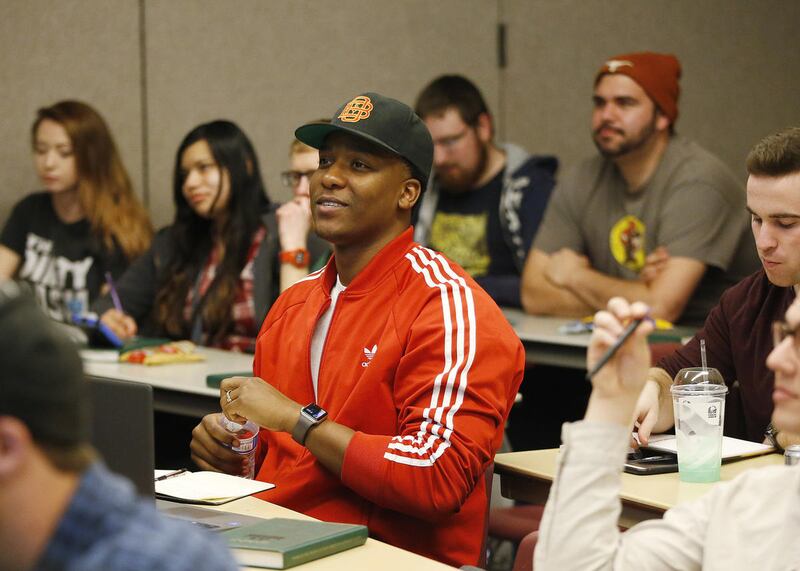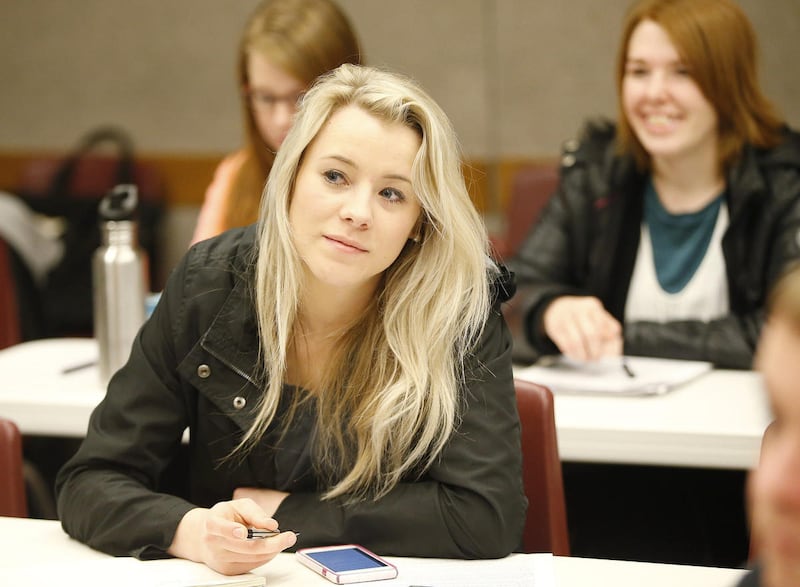OREM, Utah — Many believed they couldn't get into a university, or succeed if they did. Most were certain they could never afford it. Some had given education the old college try before and failed.
But here they are on a dark, chilly, February night. Nearly 600 students ages 17 to 70 gather in Orem, Utah, to help each other cross a bridge from their obstacles to opportunity in a college education program called Pathway.
Jane Wolferts, an Orem grandmother who took one college course back when she was raising six children — "It didn't work out so well" — is sitting at a round table practicing math problems with her young, newlywed friend, Alicia Johnson, a returned LDS missionary who immigrated from Nicaragua in July.
Both women laugh and smile easily. They are unmistakably happy.
"I never thought I could come to college," Wolferts said. "I never thought I was smart enough. Until you take a class and take a test, you don't know you can. This is my second semester, and I'm surprised how well I'm doing."
There is no teacher in the room. The 18 students sitting around three tables are enrolled in Pathway's online courses, but Pathway is a hybrid — students gather once a week at LDS Church-owned buildings around the world. Here in Orem on a Thursday night, Wolferts is listening to her group's 19th participant, the designated student leader for this week's gathering, Julie Heaton of Orem. A different student will lead the discussion next week.
More than two dozen gatherings are underway here, in the young single adult stake center, and in the Orem LDS Institute building. The buildings are full, but another 180 students have signed up to start classes in the spring, if Pathway staff can find space for them.
Across the street, lights glowing in its window-rich library, is Utah Valley University.
What is Pathway?
Earlier this month, in a rare news conference, a member of the First Presidency of The Church of Jesus Christ of Latter-day Saints announced that Pathway, an international program still in its infancy, will become part of a new venture, BYU-Pathway Worldwide.
Some immediately began to refer to it as a fourth BYU, added to Brigham Young University in Provo, Utah; BYU-Idaho in Rexburg, Idaho; and BYU-Hawaii in Laie, Hawaii.
The announcement was front-page news in Utah, but many remained unfamiliar with the concept of Pathway. The Deseret News has compiled charts, graphics, photographs and interviews to show what Pathway is, how fast it is growing and why.
Pathway is a one-year program that helps people start or return to college. It provides that path or bridge by addressing three major obstacles to college education — cost, fear and accessibility to campus — through affordable online courses ($69 per credit) designed to build confidence.
Admission is currently only available to members of the LDS Church. However, an ongoing pilot program is considering non-Mormon students at a handful of select sites.
Also, Pathway isn't reserved for those 18-26. The average age of a Pathway student is 33. Students have been as old as 92.
Pathway separates its weekly gatherings into two age groups, 18-30 and 31+.
"We have a full spectrum of people," said John Wilson, Pathway's Utah/Idaho area manager. "About half have some previous college experience. We also have people who are fully active in the church to people who have been inactive for 15 or 20 years."

"Pathway was created to make college educational opportunities available to those who otherwise would not have them," said President Dieter F. Uchtdorf of the First Presidency. "Pathway is a bridge into the world of online college education, and a pathway to opportunities for a successful livelihood."
In three semesters, a student will take a total of six online classes and earn 15 college credits. He or she also will attend weekly gatherings with other students at local LDS buildings.

Before Pathway launched in September 2009, its founders at BYU-Idaho called it "Academic Start."
That first month, Pathway had three tiny bands of students scattered among three gathering sites — Manhattan, N.Y.; Mesa, Arizona; and Nampa, Idaho.
From those initial 50 students and three sites in 2009, Pathway has grown faster than its founders ever anticipated. In 2011, Pathway administrators told a reporter they had 22 sites and expected to grow by 10 new sites per year. Two years later, the program had 129 sites. After another three years, Pathway today has 430 active sites.

The growth is so rapid that LDS Church, BYU-Idaho and Pathway leaders now refrain from setting goals, said Elder Kim Clark, who oversaw the startup of Pathway while he was BYU-Idaho's president. Now he is the Church Commissioner of Education with oversight for the four BYUs, LDS Business College and the faith's international Seminary and Institute program.
"Pathway grew so much faster than any of us expected," said Elder Clark, also a General Authority Seventy of the church. "We realized that this isn’t about us setting goals and working through it, this is us putting in place and then being ready to try and serve those people who come. We do plan, we do forecast, we do try to understand what we are doing, but I would never give you a number about what this will be. We just know it’s going to grow."
More students flock to the program each year. In the first three years, 50 students became 3,426. Three years later, there were 14,983.

It grows in part because starting the program is easy to understand and easy to access.
While Wolferts, Johnson and Heaton met in their group's math class at the YSA stake center on this cold Thursday night, students in an English class in the Institute building were exchanging papers, providing each other feedback on the second draft of an assignment due on the weekend.
Daniel Goff, 21, who has Asperger's, is from Atlanta. Pathway removed a difficult barrier to college for him. He won't have to take the ACT or SAT. Pathway doesn't require entrance exams. In fact, 3 percent of Pathway students don't have high school diplomas.

Pathway provides students like Goff and those without high school diplomas with a specific one-year bridge to becoming BYU-I online students. BYU-I's online degree program automatically accepts students who complete the Pathway year with a B average.
"I don't have to worry about any tedious testings," Goff said. "I can just get right into school."
Simple access to Pathway appealed to Hannah Hook, too. Hook, 21, married nearly two years ago. Her husband works full-time and goes to school full-time. She works full-time for a business survey data firm. She didn't think she had time to start college.
"Just working through the acceptance process and registering for classes was too much," she said.
A friend told her to look into Pathway.
"I logged into the website, and before I knew it, I was signed up," she said. "In maybe 10 minutes, I was registered. I started two days later. It was super easy, almost startling."
Like all students, she took a life skills class her first semester.
"They teach you how to learn, how to take notes, everything," she said.
Goff does his coursework online, but he enjoys the support he finds in the gathering he attends one night a week. There, his classmates say he is smart and provides them with constructive feedback.
That support is a major part of the program, said Clark Gilbert, who will step down as BYU-Idaho's president in April to become the full-time head of BYU-Pathway Worldwide
"Pathway builds confidence," said Gilbert, who helped launch Pathway in 2008-09.
Pathway, unlike the church's other higher education offerings, does not require a student to provide an endorsement from an ecclesiastical leader. The program is designed to help students build their spiritual lives, too.
"The goal is spiritual growth and college readiness," Gilbert said. "Yes, we are preparing students and giving them the skills they need to succeed in college. Spiritual growth is related."
Orem is the largest Pathway site, but gatherings are held in 430 active sites. The program is truly international, with 221 sites in the United States and Canada and 209 in 67 other countries around the world.

Students who complete Pathway continue to pay $69 per credit hour if they enroll in the BYU-Idaho online degree program. That means a bachelor's degree, which takes 120 credit hours, will cost them about $8,000, less than half the cost of an in-state bachelor's degree at a public university.
BYU-Pathway Worldwide will combine the two programs, Pathway and BYU-I's online offerings, in one.
Outside the United States, Pathway tuition is tied to income levels. In Ghana, for example, a Pathway credit-hour costs about $10, Elder Clark said.

How does Pathway keep costs so low?
First, there are no building costs, because Pathway gatherings are held at existing LDS buildings around the world. Second, the online professors are already employed and paid by BYU-Idaho. Third, senior service missionary couples who mentor and oversee the weekly gatherings are unpaid. Fourth, little marketing is necessary, thanks to word-of-mouth and referrals by ecclesiastical leaders.
One of the only obstacles to growth is the number of service missionaries.

"Pathway is always looking for missionaries," said John Wilson, Pathway's Utah/Idaho area manager.
Service missionaries do not teach. They preside at gatherings of 20 or fewer students. Pathway uses a "lead student" model. Students come to class prepared for the discussion, and one leads it.
Service missionaries regularly provide support to the lead student, who may be nervous.
"It's been a wonderful experience for us," said Sister Karin Crawford, who taught dental hygiene at USC and serves now with her husband, Elder Tom Crawford, an orthodontist. "We've spent three years working with students 31 and older. These are people — life happened to them. They have heartbreaking, wonderful stories."
Julie Heaton, the lead student in the Crawfords' group on this night, doesn't seem nervous at all behind her black-rimmed glasses. She dressed up for the occasion, with hoop earrings, a black blouse and a black-and-white skirt.
Her brother, Scott Heaton, says Julie may not be as cool as she appears on the surface.
The Heatons are taking Pathway with their sister, Lois Gilson, of Springville, Utah. All three were adopted by their parents, who introduced them to Pathway. Scott and Julie were born in Costa Rica.
"It was very easy for me to be a lead student," said Scott Heaton, who wore a suit when he led the class. Today he is wearing a black hoodie, blue jeans and a baseball cap. "For people like Lois and Julie, it's harder. It's really out of their comfort zone. What makes it easy is we are all supportive of the lead student. We're so open about feeling nervous, so we can help each other if someone is struggling.
"It's definitely a safe place to learn."
Closeness is a common theme. In another room, Sylvestre Banhie, a student from the Ivory Coast, finishes leading a discussion about time management in a life skills gathering for students 31 and older. Elder John Robertson, a former BYU professor, stands up and comments on the group's cohesion.
"When this group is over," he says, "you'll miss each other."
Education mission
An hour before the meetings begin on this Thursday night, 53 service missionaries like Robertson gather for orientation. They are buzzing about the announcement of BYU-Pathway Worldwide.
A church employee asks for their feedback. He is preparing to design an update to the computer system the missionaries use to track students . One of the missionaries asks him to make the system as simple as possible, pointing out that all the missionaries are seniors.
"We were not born with a computer chip in our head," she says.
The room fills with laughter. There are former BYU professors, former stake presidents and Relief Society presidents and retired power couples. Steve Clark is a former member of the Utah House of Representatives. His wife, Cindy, is a former Provo City Councilwoman.
People who want to serve as service missionaries can apply and are called through their stake presidents — the leaders of a group of LDS congregations.
"Senior couples love being Pathway service missionaries," Wilson said, "because they can serve their missions and live at home, see their grandkids and go to their baptisms."
16 of the first 50 Pathway students completed the program within a year. Today, the completion percentage is far higher. Given these students' nontraditional nature, starts and stops are expected.
Jessica Street, an unemployed mother of five, is in the middle of a divorce. She left her husband a week after starting Pathway the first time.
"Last year I decided to take life by the horns and start my own path," Street said. "But then I had to stop and figure out how to provide for my family. I'm redoing Pathway because it just got too hard for me last year, but Pathway gave me stability and a place to feel safe, which is another aspect of Pathway I love. This program will set me up so I don't have to worry too much about the cost of education."
Street is one of nearly 59,000 students who have started Pathway in its seven years. More than 39,000 have completed Pathway and enrolled at BYU-Idaho on campus, or in BYU-Idaho's online degree program.

Pathway also has a program specifically designed to help those learning English as a second language.
While the program has more than 3,000 students in 62 countries outside the United States and Canada, it could grow faster if it was multilingual.
"I think the biggest impediment to the growth of this worldwide is English," Elder Clark said. "We made a decision that all these programs will be done in English, because English capacity, the ability to read, write and speak English, understand English, has enormous value everywhere."
Elder Clark said the program will continue to focus on English wherever it is. Overseas, the vast majority of students are taking special English classes.
"We often have, when we open up a site, we always hold a meeting," Clark said, "an informational meeting, and we will get hundreds of people who come. Of those hundreds, I would guess maybe 20 percent have the English ability required to do the program. So we have launched a major effort in English language instruction, to help people develop the English skills they need to do the program. The program itself really improves their English, but if we can get people prepared, many more of them will be able to participate in these programs."
To learn more or apply for Pathway, visit pathway.lds.org.

